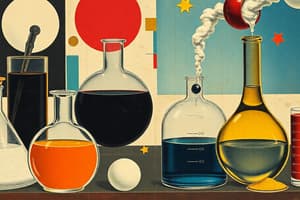Podcast
Questions and Answers
How do you define solids, liquids, and gases?
How do you define solids, liquids, and gases?
They are defined by whether or not they hold their shape and volume.
What defines a solid?
What defines a solid?
Has a definite shape and a definite volume.
Why do solids have a definite shape and a definite volume?
Why do solids have a definite shape and a definite volume?
Because the particles that make up a solid are packed very closely together.
Are the particles in a solid completely motionless?
Are the particles in a solid completely motionless?
How do the particles in a solid move?
How do the particles in a solid move?
What type of solid's particles form a regular repeating pattern?
What type of solid's particles form a regular repeating pattern?
What type of solid's particles do not form a regular pattern?
What type of solid's particles do not form a regular pattern?
What type of solid is salt?
What type of solid is salt?
What type of solid is rubber?
What type of solid is rubber?
What type of solid melts at a specific temperature?
What type of solid melts at a specific temperature?
What type of solid becomes softer or changes to another substance when heated?
What type of solid becomes softer or changes to another substance when heated?
What defines a liquid?
What defines a liquid?
When a short fat cup has 10 ounces of milk, and the milk is poured into a tall glass, the volume increases. True or false? Why?
When a short fat cup has 10 ounces of milk, and the milk is poured into a tall glass, the volume increases. True or false? Why?
Why don't liquids have a definite shape?
Why don't liquids have a definite shape?
What property of particles makes liquids flow?
What property of particles makes liquids flow?
A substance that flows is called a?
A substance that flows is called a?
What is the characteristic property of liquids due to the inward pull among the molecules that brings the molecules on the surface closer together?
What is the characteristic property of liquids due to the inward pull among the molecules that brings the molecules on the surface closer together?
What property of water allows a water strider to 'walk' on the calm surface of a pond?
What property of water allows a water strider to 'walk' on the calm surface of a pond?
What property of a liquid describes its resistance to flowing?
What property of a liquid describes its resistance to flowing?
What does a liquid's viscosity depend on?
What does a liquid's viscosity depend on?
Which liquids flow quickly? Which flow slowly?
Which liquids flow quickly? Which flow slowly?
Other than liquids, what is another fluid?
Other than liquids, what is another fluid?
How is a gas defined?
How is a gas defined?
How does breathing demonstrate that gases are fluids?
How does breathing demonstrate that gases are fluids?
What property of liquids causes water to form droplets?
What property of liquids causes water to form droplets?
Flashcards are hidden until you start studying
Study Notes
States of Matter Overview
- Matter exists in three primary states: solids, liquids, and gases, defined by shape and volume.
Solids
- Solids possess a definite shape and a definite volume.
- The particles in a solid are closely packed together, which restricts their movement.
- Although particles in solids are not motionless, they vibrate slightly in place.
- Crystalline solids have particles arranged in a regular repeating pattern, such as salt.
- Amorphous solids have particles that do not form a regular pattern, such as rubber.
- Crystalline solids melt at specific temperatures, while amorphous solids soften or change into another substance when heated.
Liquids
- Liquids have a definite volume but take the shape of their container.
- The property of liquids to flow results from freely moving particles.
- A fluid is defined as any substance that flows, which includes both liquids and gases.
- Surface tension in liquids is caused by the inward pull among molecules, allowing the surface to behave as an elastic layer.
- For example, water striders can "walk" on water due to surface tension.
- Viscosity is a measure of a liquid's resistance to flow, influenced by particle size, shape, and inter-particle attractions.
- Liquids with high viscosity (e.g., honey) flow slowly, while those with low viscosity (e.g., water) flow quickly.
Gases
- Gases have neither a definite shape nor a definite volume.
- The properties of gases allow them to flow freely, as demonstrated by the breathing process where air moves in and out of the body.
Studying That Suits You
Use AI to generate personalized quizzes and flashcards to suit your learning preferences.




